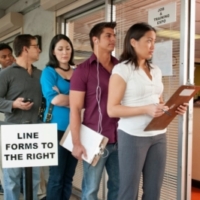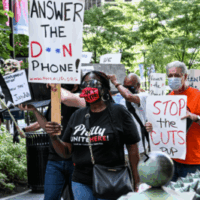Policymakers should immediately extend federal loans to state unemployment agencies for at least three years
In the United States, the unemployment insurance (UI) system has served as a crucial support for workers’ economic stability and shared prosperity for more than 80 years. During hard times, workers who have lost their jobs tap into the unemployment system to receive a share of lost wages while searching for new work.
Time and time again, the UI system has buttressed the U.S. economy, including during the Great Recession and its aftermath. Reports from leading labor scholars found that UI lifted more than five million people out of poverty and saved more than two million jobs in 2009 alone. During the worst years of the Great Recession, UI prevented 1.4 million foreclosures[i] and made up more than 18 percent of the shortfall in U.S. gross domestic product.[ii] UI is one of the best returns on investment of any countercyclical economic program. During the height of the last recession, every dollar spent in unemployment insurance generated $1.61 in economic activity.
Without additional federal support, state unemployment insurance trust funds—out of which states pay benefits—will run dry.
The Great Recession made clear the critical importance of a resilient UI program. But states’ response to that recession exposed cracks in the U.S. unemployment system. Some states that exited the last recession with depleted UI trust funds and loans from the federal government chose to restore those trust funds by cutting benefits and limiting access.
Benefit access was most restricted in states that tend to have more workers of color, including southern states like Florida, North Carolina, South Carolina, Georgia, and Tennessee. Michigan increased fraud policing and decreased benefit duration, and not coincidentally, cities such as Detroit and Flint never recovered from the last recession. If we exit the impending recession in a worse position, which seems inevitable, the system will face an existential challenge as a result of the COVID-19 crisis.
Unemployment Crisis Demands Federal Assistance
Today, workers who have held a steady job for the better part of their lives are suddenly finding themselves out of work. We already know that the number of unemployment claims resulting from COVID-19 pandemic will surpass the number of unemployment claims from the entirety of the Great Recession. Economists calculated that the unadjusted unemployment rate in the United States has already surpassed 20 percent nationwide, with COVID-19’s effects disproportionately falling along racial lines as a result of occupational segregation, discrimination, and other labor market disparities. Unemployed workers are still unable to file for benefits as state agencies buckle under the crushing volume of new claims. Meanwhile, the economic contraction is only expected to accelerate.
Because of this unexpected strain, there is an urgent need for greater federal support for the UI system. Without additional federal support, state UI trust funds—the well that states rely on to pay benefits—will run dry. Federal policymakers must immediately extend federal loans to state unemployment agencies for a period of at least three years. A failure to do so would leave the nation at even greater risk of a catastrophic economic downturn.
It’s important to have a basic understanding of how the UI system works to appreciate why at least three years of federal loans is so critical. The UI system operates as a federal-state partnership, where federal requirements set minimum standards for state-administered unemployment programs. Outside of these federal standards, state programs are afforded the flexibility to adopt their own standards. This flexibility includes a state’s strategy for replenishing its UI trust fund, the well of money used to pay benefits during normal times.
After the Great Recession emptied every state’s UI trust fund, states received only a limited amount of federal loans. These federal loans quickly dried up. Some states then adopted harsh measures to restrict unemployment benefits while attempting to replenish trust funds.
North Carolina, for example, implemented austerity measures that slashed the amount and duration of unemployment benefits. Such austerity measures contravene research that demonstrates that economic recovery is bolstered when UI recipiency is high. In Michigan, unemployment officials relied on more than $3.8 billion in bond-financed debt to weather the Great Recession. After 12 years of paying off those bonds through a combination of higher business tax rates (which hurt employers) and austerity measures and benefit cuts (which hurt workers), Michigan finally paid off its debt.
Weeks later, COVID-19 hit.
Without additional federal action, this recent history tells us that states may take steps that harm long-term recovery at the expense of workers, employers, and the economy. But the federal government can avoid this unnecessary outcome by extending federal loans to support state UI programs for a period of at least three years. This idea is not a radical one.
A few weeks ago, California became the first state to tap into U.S. Treasury Department funds for UI when it borrowed $348 million in loans. Now, Illinois, Connecticut, Hawaii, Massachusetts, New York, Ohio, Texas, and West Virginia have been approved for similar federal loans. However, all these states face restrictions on their use of these funds. Most problematically, these states must use their loans before the summer ends, despite the fact that unemployment rates will almost certainly remain high for much longer.
The Need for Three-Year Federal Loans
So why does it make sense for the federal government to extend support to state unemployment agencies for the entire length of this crisis?
Extending federal loans to state UI programs makes sense for several reasons. First, federal loans are needed to ensure that states can continue to pay out benefits. No one knows how long this crisis will last, but economists predict that the economic downturn will last far beyond 2020. State UI programs may need to draw on federal resources through 2023, as the path to recovery is simply too uncertain to know when those UI programs will be solvent once again. Increasing access to federal loans for three years gives states a reliable and essential source of funding throughout the long road to recovery. Additionally, a three-year loan program allows federal lawmakers to turn their attention to other pressing issues, rather than having to enact emergency measures whenever a future crisis arises.
Increasing access to federal loans also means that a state will not feel the need to turn to the bond finance market to make benefit payments. After the Great Recession, states were strapped with billions of dollars in bond debt. To pay off this debt, states increased business taxes, which added costs to employers, putting downward pressure on the recovery. If Congress acts to increase access to federal loans for UI, states can avoid incurring debt from the bond market, thereby maintaining low corporate tax rates and supporting employers’ recovery.
Increasing access to federal loans also forestalls harsh austerity measures, which dampen economic growth and harm workers. Overall, providing extended federal loans to state UI programs speeds up the nation’s recovery in a fiscally responsible way, since the return on investment for unemployment spending is high—it’s one of the best countercyclical economic programs available.
In this time of great uncertainty, extending access to federal loans for state UI programs is one surefire way to support those who’ve lost jobs and income due to the COVID-19 public health crisis. Federal lawmakers must extend loans to state UI agencies for at least three years in order to support the UI system and help it mitigate the crushing economic instability caused by COVID-19.
Acknowledgments
This brief was written by Rachael Kohl, Director, University of Michigan Law School Workers’ Rights Clinic; Dillon Roseen, Student Attorney, University of Michigan Law School Workers’ Rights Clinic; and Michele Evermore, Senior Policy Analyst, National Employment Law Project.
Endnotes
[i] Matt O’Brien, “Unemployment Insurance Prevented 1.4 Million Foreclosures,” Washington Post. August 6, 2014
[ii] Wayne Vroman, “The Role of Unemployment Insurance as an Automatic Stabilizer During a Recession” (Washington: IMPAQ International, 2010), available at http://wdr.doleta.gov/research/FullText_Documents/ ETAOP2010-10.pdf
Related to
Related Resources
All resourcesCase Study: How Virginia Worker Advocates Advanced Unemployment Insurance Reform in a Divided State Government

Policy & Data Brief
Letter on Making Reforms to Virginia’s Unemployment Insurance System

Comments & Letters
Letter on Rescinding Funds for Improving Unemployment Insurance Systems

Comments & Letters

